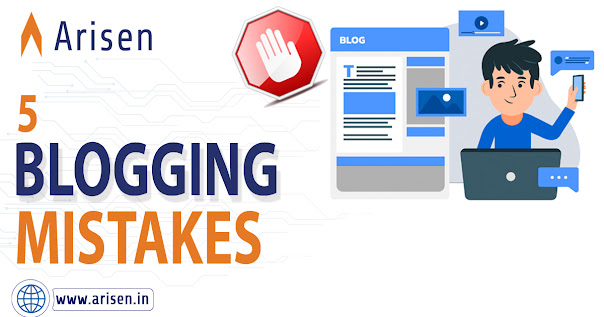While blogging can be rewarding and lucrative, it’s not as simple as you might believe. These are 5 typical blogging mistakes to avoid, along with suggested fixes.
Making blogging mistakes is a necessary aspect of being a blogger, regardless of how new you are or how much experience you have. I’m removing the curtain today to show you 15 typical blogging errors individuals make and what to avoid.
I’ve been blogging for three years and five of those years have seen me crash my bike into almost every kern in the area. There’s no reason for you to follow suit.
Utilize this manual as a collection of starting points for a fruitful blogging career. I’m eager to find out how far you can ride. Here are the top 5 blogging mistakes which are you should know.
1: Not having a clear purpose for your blog
Starting a blog without a clear objective is one of the major mistakes that new bloggers make.
Nobody starts off with everything worked out, but having a basic direction helps you be more deliberate with your time and creative energy.
There’s no point in constructing a high-end skyscraper if all you want is a cabin by the lake, is there?
Depending on the results you hope to achieve, your blog will take on a completely distinct appearance.
Some people start a blog to advertise a small business or product they already have. In light of the fact that businesses with blogs receive 55% more internet traffic, blogging can be a fantastic addition to your other marketing initiatives.
Some start blogs in order to work for themselves and earn money online. According to a 2020 research of more than 1000 bloggers, 16% of people who started blogging did so to work for themselves and 12% did it to increase their income.
But why do people start blogging the most frequently? It’s fun! Over 24% of bloggers, according to the same study, started their blogs as a means of creative expression.
All of these are good reasons to start a blog, but your priorities will change depending on whether you blog for fun, as a marketing tool, or as a way to make money.
Blogging Mistakes 2: Blogging without a niche
Let’s say you’re planting a vegetable garden. You turn to the internet in search of advice. Which website appeals to you more: a broad blog about growing hundreds of plant types or a blog exclusively about developing a garden full of veggies?
Given that the second blog is more in line with your interests, chances are good that you’ll choose it. Additionally, you can infer that the author is an expert in vegetable gardens as that topic is the primary focus of their website.
Thoroughness: When you adhere to a certain idea, you can cover it in more detail than if you were writing about several distinct hobbies.
Advantages of search engines: A search engine’s algorithm has to choose the top websites to show when someone types a question into the search bar.
Expert status: You want to be regarded as “that veggie garden guru” in the minds of your readers, but that probably won’t happen if your blog also covers beauty products, holiday destinations, and interior design.
Related Articles:
Top 9 Financial Tools for Business Startups | You Need to Know
Top 5 SEO Marketing Challenges 2023
Top 11 Digital Marketing Trends for 2023
3: Focusing on your own interests instead of your audience
Although it may seem strange, the lead blogger isn’t the most crucial figure in the development of content. It all comes down to the audience.
Focus on producing content that your target audience wants to read rather than worrying about the articles you want to write.
How can you ascertain what your readership wants to read?
Check forums on Reddit and Facebook to see what inquiries individuals in your niche are making as you begin your market research.
Also, you can enter keywords into the search fields on YouTube, Google, and Pinterest to see what related searches are suggested. You can use these as topics for blog posts because these are common search terms that actual people use.
Blogging Mistakes 4: Skipping steps when setting up your blog
Although it can be tempting to jump through hoops during blog setup. It’s important to take your time and address all technical issues right away.
You must pick a blogging platform that supports your goals if you intend to blog professionally. The two most well-liked choices are Squarespace and WordPress.
I’m a WordPress gal myself, and I’m in good company. Almost 42% of all websites utilize WordPress, which is widely regarded as the blogging industry standard.
Last but not least, set aside a weekend to watch tutorials, study plugins, and read up on website configurations.
After discovering that my site was not properly optimized around two years after running my first blog, I spent a whole month upgrading articles and overhauling the structure of my website. I see now that I could have saved myself from the trouble later on if I had done more research in the beginning.
Blogging Mistakes 5: Ignoring SEO and keyword research
Later in their careers, many bloggers pick up knowledge of keyword research and search engine optimization (SEO). Studying these important skills from the start will help you stand out.
SEO is a method for producing content that performs well in Google and other search engines. You’ll probably get more website views as your content rises in the rankings. According to 71% of bloggers, SEO is a significant source of visitors to their blogs.
The words and queries that users enter into the search box are known as keywords. Ideally, your material should show up when consumers look up topics associated with your expertise.
Early on, you may better understand how search engines operate and relate to your website. You can learn a few fundamental SEO principles.
Check out our list of free SEO tools. Our guide to SEO for creators for a deeper look at everything SEO.












